Optimization of Agricultural Tractor Engine Hood Forming Quality Based on Neural Network Genetic Algorithm Function
Abstract
1. Introduction
2. Simulation Analysis of Agricultural Tractor Engine Hood
2.1. Construction of the 3D Model
2.2. Selection of Material Model
2.3. Stretch Forming Analysis
3. Orthogonal Experiments and Grey Relational Analysis
3.1. Selection of Process Parameters
3.1.1. Blank Holder Force
3.1.2. Stamping Speed
3.1.3. Friction Coefficient
3.1.4. Die Clearance
3.2. Selection of Quality Evaluation Indicators
3.3. Orthogonal Experimental Design
3.4. Grey Relational Analysis
4. Optimization of Parameters in a Genetic Algorithm Function Optimization Model Based on Neural Networks
4.1. Latin Hypercube Sampling
4.2. Construction of the Mathematical Model for the Optimization Object
4.3. Neural Network Genetic Algorithm Function Optimization
4.3.1. BP Neural Network Construction
4.3.2. Genetic Algorithm Optimization
4.3.3. Result Analysis Verification
5. Validation of Simulation Research
6. Conclusions
- (1)
- The results of the quality evaluation indicated that wrinkling and cracking were the main quality problems of the part.
- (2)
- Grey relational analysis indicates that the blank holder force and die clearance have a significant impact on the “maximum thickening rate” and “maximum thinning rate”, whereas the impact of the stamping speed and friction coefficient on these rates is smaller.
- (3)
- In the pursuit of minimizing the “maximum thickening rate” and “maximum thinning rate”, the neural network genetic algorithm function optimization model was used to optimize the process parameters of the engine hood, obtaining the optimal combination of process parameters: the blank holder force of 462.71 kN, die clearance of 1.09 mm, and the corresponding “maximum thickening rate” and “maximum thinning rate” of 3.97% and 25.96%, respectively, with an average error value of 0.675% compared with the simulation result.
Author Contributions
Funding
Institutional Review Board Statement
Informed Consent Statement
Data Availability Statement
Conflicts of Interest
References
- Zhu, M.Y.; Fu, J.; Cui, L.C. Optimization of stamping parameters for G series forklift engine hood. Forg. Stamp. Technol. 2014, 39, 27–30. [Google Scholar]
- Wang, S.F.; Chen, S.F.; He, X.H. Numerical analysis of stamping forming for special-shaped thin-walled stainless steel heat shield. J. Plast. Eng. 2022, 29, 19–27. [Google Scholar]
- Qin, B.Y.; Qin, W.D.; Lin, X.K. Application of response surface method to optimize process parameters in engine heat shield forming. Forg. Stamp. Technol. 2016, 41, 22–28. [Google Scholar]
- Wu, A.M. Stamping simulation test and analysis on automobile stainless steel cover plate. Forg. Stamp. Technol. 2021, 46, 131–135. [Google Scholar]
- Zheng, S.H. Numerical Simulation and Process Optimization of Deep Drawing of Double Box Stainless Steel Sink. Ph.D. Thesis, Zhejiang University of Technology, Hangzhou, China, 2020. [Google Scholar]
- Hang, T.P.; Takeshi, I. An evaluation of fracture properties of type-304 austenitic stainless steel at high deformation rate using the small punch test. Int. J. Mech. Sci. 2018, 144, 249–261. [Google Scholar]
- Zhang, Y.; Gu, X.; WU, H.L. Influence and Prediction of Transition Zone Parameters on Hydraulic Bulging Properties for TRB Tube. Forg. Stamp. Technol. 2017, 42, 99–104. [Google Scholar]
- Fathi, H.; Emadoddin, E.; Mohammadian, S.H.R. Effect of punch speed on the formability behaviour of austenitic stainless steel type 304l. Met. Mater. Int. 2016, 47, 3897–3911. [Google Scholar]
- Wang, S.; Wu, Y.; Ma, Y.M. Finite Element-based Analysis and Optimization of Agricultural Tractor Fender Bending. J. Shandong Agric. Univ. (Nat. Sci. Ed.) 2023, 54, 782–791. [Google Scholar]
- He, Q.Z.; Li, H. Optimization and Prediction of Ironing Process for Cylindrical Parts Based on Grey System Theory. J. Plast. Eng. 2019, 26, 57–62. [Google Scholar]
- Xiong, W.T.; Xie, S.S.; Huang, Z.F. Optimization of drawing forming for front panel of an automobile based on neural network genetic algorithm function optimization and SCP technology. J. Plast. Eng. 2020, 27, 38–45. [Google Scholar]
- Xiong, W.T.; Liu, J.; Huang, Z.F. Optimization of Automobile Crossbeam Forming Based on Neural Network Genetic Algorithm Function Optimization and Springback Compensation. Hot Work. Technol. 2019, 48, 68–74. [Google Scholar]
- Tian, Y.; Lv, M.D.; Huang, Y.P. Parameter optimization of stamping process on auto front door reinforcing plate. Forg. Stamp. Technol. 2014, 39, 35–38. [Google Scholar]
- Xiong, W.T.; Liu, H.B.; Li, H.W. Optimization of Sheet Metal Forming Based on GS theory and Neural Network Genetic Algorithm. Mach. Des. Res. 2016, 32, 118–122. [Google Scholar]
- Li, Y.Y.; Hu, C.R. Experiment Design and Data Processing, 2nd ed.; Chemical Industry Press: Beijing, China, 2020; pp. 164–166. [Google Scholar]
- Xie, Y.M.; Wang, X.B.; Wang, Z. Parameter Inverse Problem for Drawbeads Based on the Gray Theory and GA-BP. J. Mech. Eng. 2013, 49, 44–50. [Google Scholar] [CrossRef]
- Xiong, W.T.; Liu, H.B.; Sun, Y.G. Forming optimization of automobile covering parts based on GS theory and neural network. Ord. Mater. Sci. Eng. 2017, 40, 84–89. [Google Scholar]
- Guo, Q.; Zheng, Y.P.; Zhu, W.Q. Research on high strength steel forming based on BP neural network genetic algorithms. Mater. Sci. Technol. Lond. 2020, 28, 89–96. [Google Scholar]
- Wang, X.C.; Shi, F.; Yu, L. 43 Case Studies of MATLAB Neural Networks, 2nd ed.; Beihang University Press: Beijing, China, 2011; pp. 17–18, 34–35. [Google Scholar]
- Feng, Q.Q.; Zhou, X. Automated and Robust Multi-Objective Optimal Design of Thin-Walled Product Injection Process Based on Hybrid RBF-MOGA. Int. J. Adv. Manuf. Technol. 2019, 101, 2217–2231. [Google Scholar] [CrossRef]


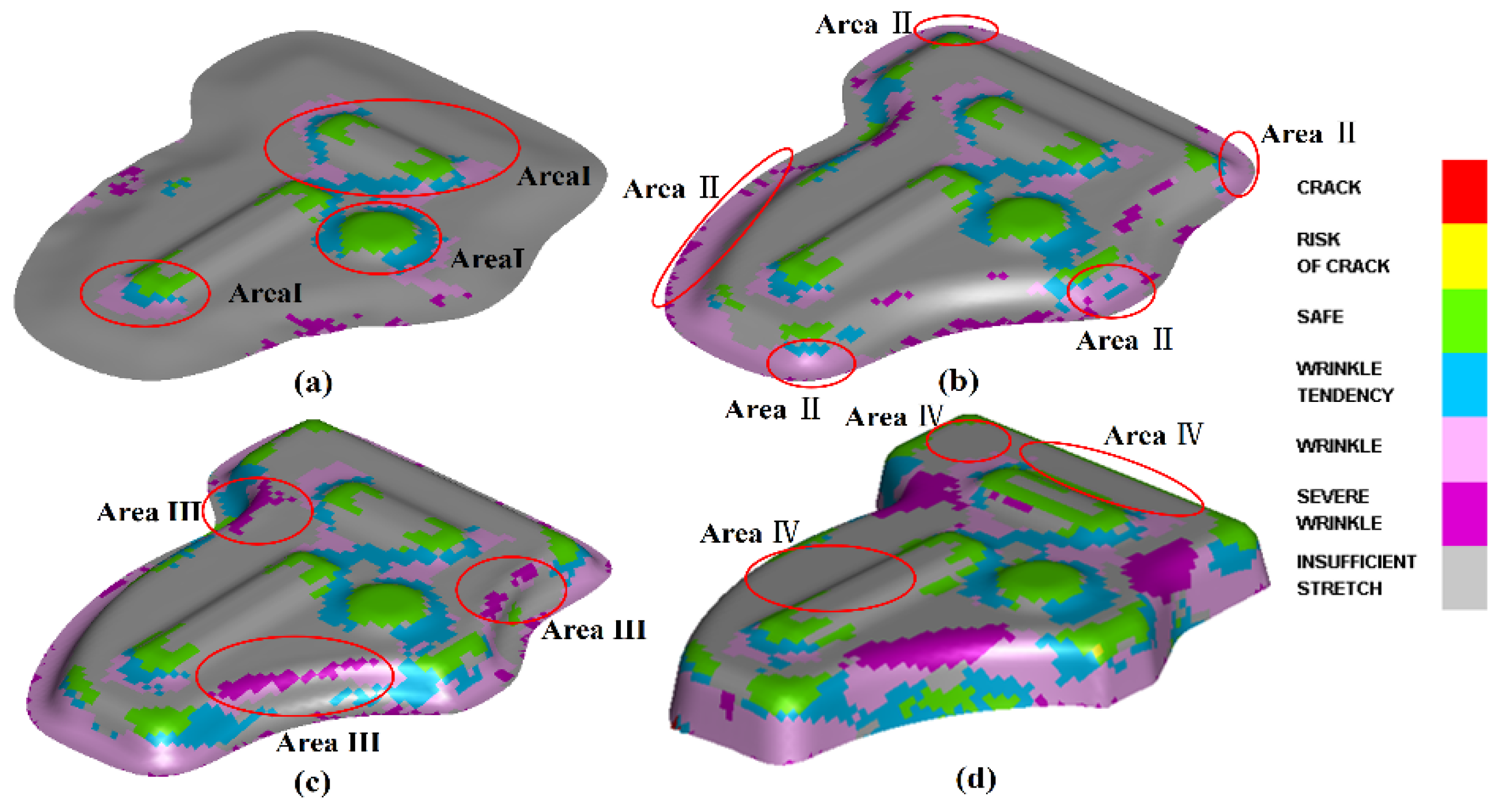
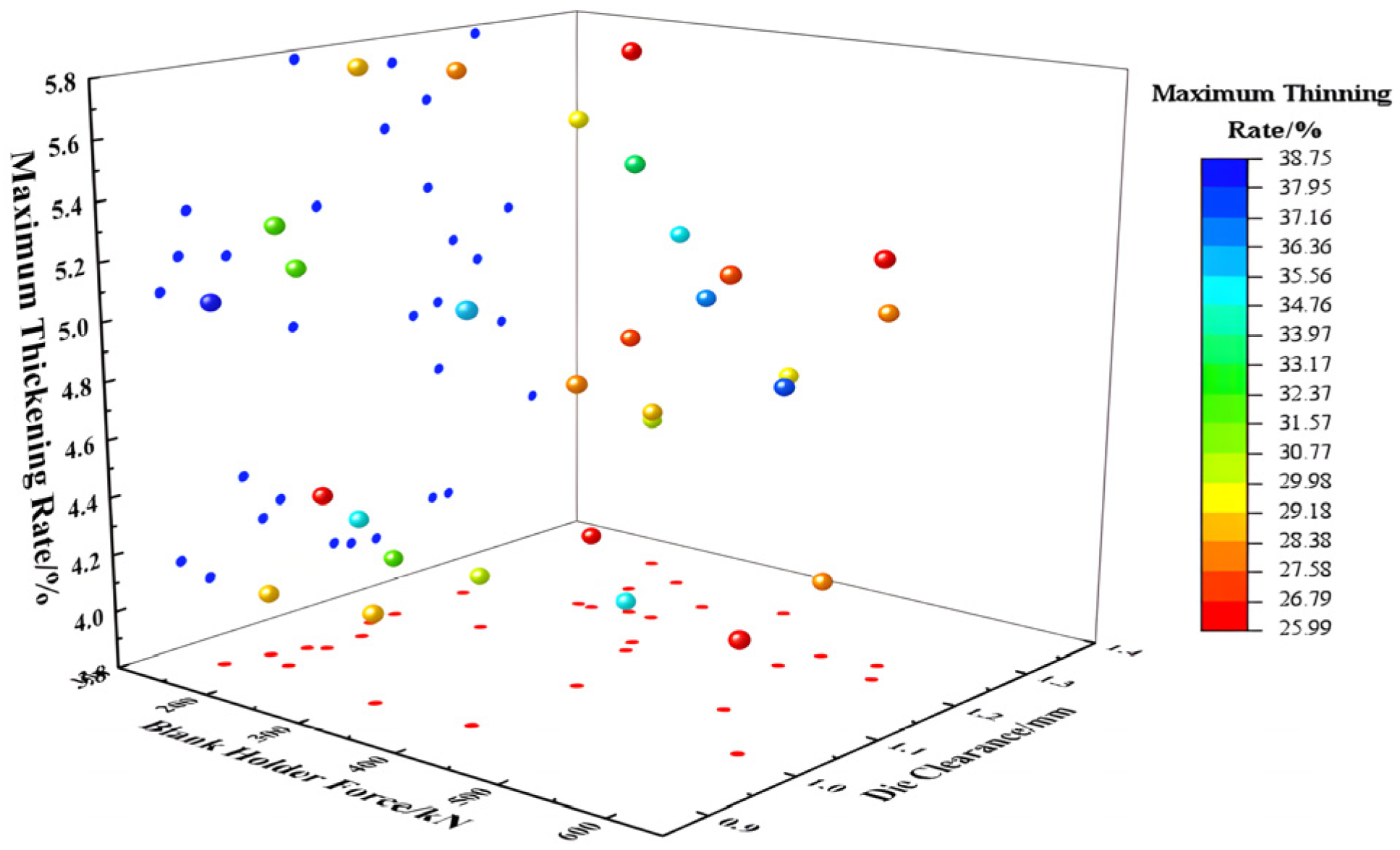
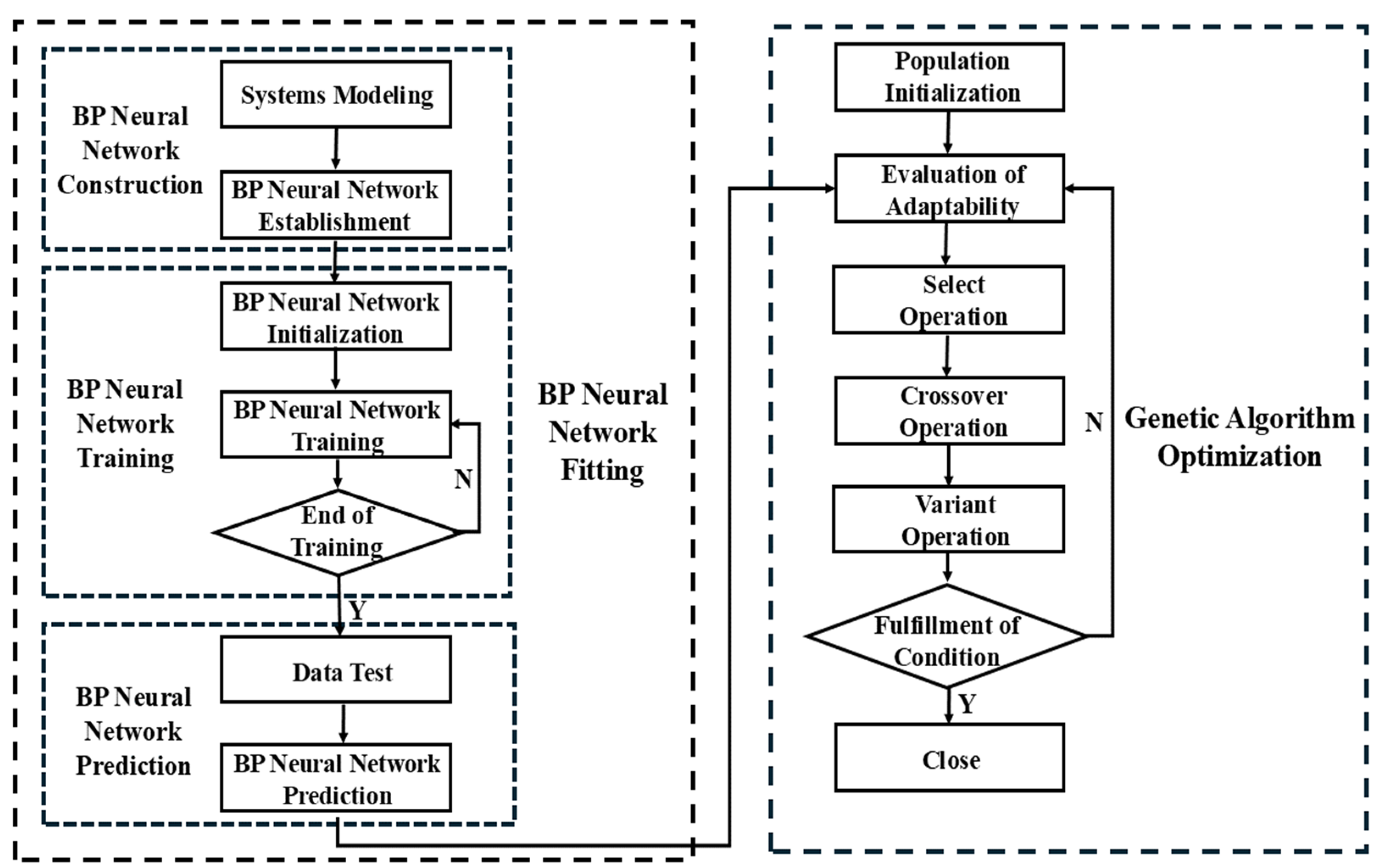

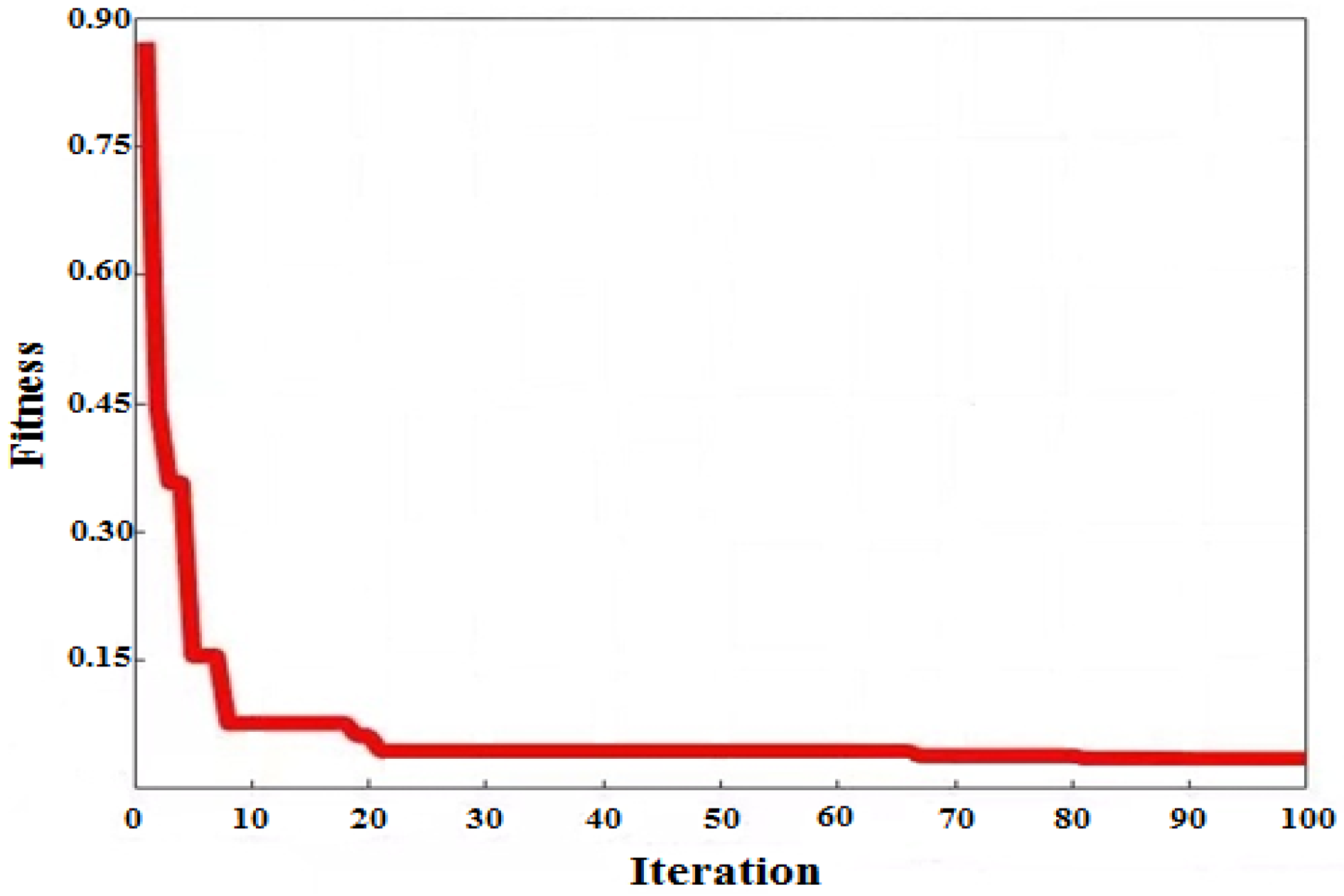
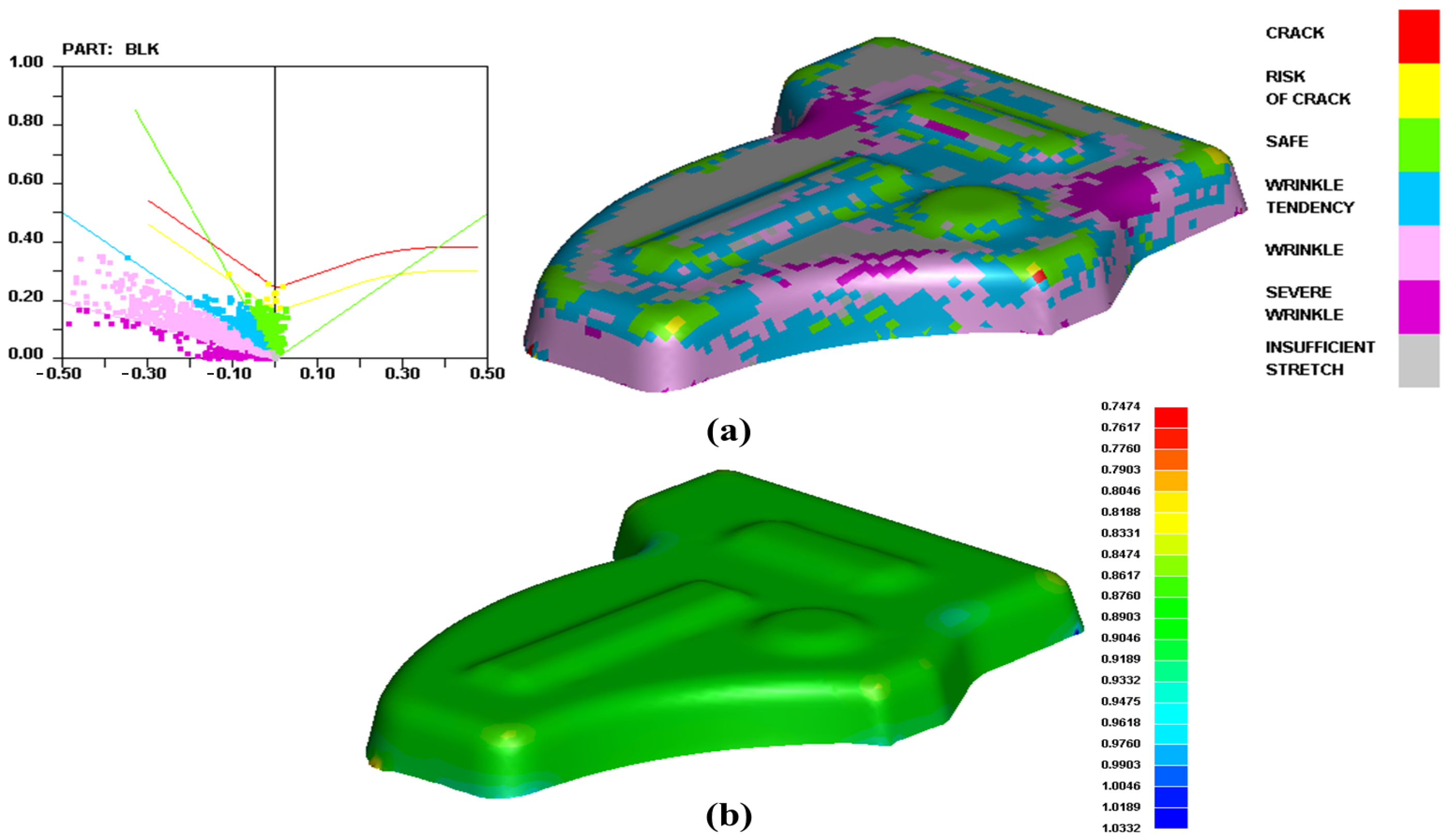
| Parameter | Density P /G·cm3 | Young’s Modulus E /GPa | Poisson’s Ratio µ | Index m | Anisotropy Parameter | ||
|---|---|---|---|---|---|---|---|
| r0 | r45 | r90 | |||||
| Value | 2.7 | 69 | 0.33 | 0.80 | 0.735 | 0.55 | 0.665 |
| Test Factor /Level | Blank Holder Force /kN | Stamping Speed /mm·s−1 | Friction Coefficient | Die Clearance /mm | Blank Column |
|---|---|---|---|---|---|
| 1 | 150 | 1000 | 0.050 | 0.90 | 1 |
| 2 | 300 | 3000 | 0.075 | 1.05 | 2 |
| 3 | 450 | 5000 | 0.100 | 1.20 | 3 |
| 4 | 600 | 7000 | 0.125 | 1.35 | 4 |
| Test Program | Test Factor | Quality Evaluation Indicator | |||||
|---|---|---|---|---|---|---|---|
| Blank Holder Force /kN | Stamping Speed /mm·s−1 | Friction Coefficient | Die Clearance /mm | Blank Column | Maximum Thickening Rate /% | Maximum Thinning Rate /% | |
| 1 | 150 | 1000 | 0.050 | 0.90 | 1 | 5.32 | 35.26 |
| 2 | 150 | 3000 | 0.075 | 1.05 | 2 | 4.86 | 29.78 |
| 3 | 150 | 5000 | 0.100 | 1.20 | 3 | 5.32 | 31.19 |
| 4 | 150 | 7000 | 0.125 | 1.35 | 4 | 5.01 | 31.96 |
| 5 | 300 | 1000 | 0.075 | 1.20 | 4 | 5.86 | 30.39 |
| 6 | 300 | 3000 | 0.050 | 1.35 | 3 | 5.46 | 32.08 |
| 7 | 300 | 5000 | 0.125 | 0.90 | 2 | 6.01 | 28.98 |
| 8 | 300 | 7000 | 0.100 | 1.05 | 1 | 5.58 | 38.69 |
| 9 | 450 | 1000 | 0.100 | 1.35 | 2 | 5.49 | 39.61 |
| 10 | 450 | 3000 | 0.125 | 1.20 | 1 | 4.75 | 32.54 |
| 11 | 450 | 5000 | 0.050 | 1.05 | 4 | 4.96 | 30.97 |
| 12 | 450 | 7000 | 0.075 | 0.90 | 3 | 5.07 | 38.95 |
| 13 | 600 | 1000 | 0.125 | 1.05 | 3 | 4.84 | 32.35 |
| 14 | 600 | 3000 | 0.100 | 0.90 | 4 | 5.34 | 33.89 |
| 15 | 600 | 5000 | 0.075 | 1.35 | 1 | 5.56 | 31.71 |
| 16 | 600 | 7000 | 0.050 | 1.20 | 2 | 5.19 | 30.57 |
| Test Program | “Maximum Thickening Rate” Affiliation | “Maximum Thinning Rate” Affiliation | Score |
|---|---|---|---|
| 1 | 0.45 | 0.59 | 0.52 |
| 2 | 0.09 | 0.08 | 0.08 |
| 3 | 0.45 | 0.21 | 0.33 |
| 4 | 0.21 | 0.28 | 0.24 |
| 5 | 0.88 | 0.13 | 0.51 |
| 6 | 0.56 | 0.29 | 0.43 |
| 7 | 1.00 | 0.00 | 0.50 |
| 8 | 0.66 | 0.91 | 0.79 |
| 9 | 0.59 | 1.00 | 0.79 |
| 10 | 0.00 | 0.33 | 0.17 |
| 11 | 0.17 | 0.19 | 0.18 |
| 12 | 0.25 | 0.94 | 0.60 |
| 13 | 0.07 | 0.32 | 0.19 |
| 14 | 0.47 | 0.46 | 0.47 |
| 15 | 0.64 | 0.26 | 0.45 |
| 16 | 0.35 | 0.15 | 0.25 |
| Process Parameter | k1 | k2 | k3 | k4 | Range |
|---|---|---|---|---|---|
| Blank Holder Force | 0.292 | 0.557 | 0.435 | 0.340 | 0.265 |
| Stamping Speed | 0.503 | 0.287 | 0.365 | 0.470 | 0.216 |
| Friction Coefficient | 0.345 | 0.410 | 0.595 | 0.275 | 0.201 |
| Die Clearance | 0.522 | 0.310 | 0.315 | 0.477 | 0.232 |
| Process Parameter | Relatedness |
|---|---|
| Blank Holder Force /kN | 0.86 |
| Stamping Speed /mm·s−1 | 0.61 |
| Friction Coefficient | 0.46 |
| Die Clearance /mm | 0.78 |
| Serial Number | Blank Holder Force/kN | Die Clearance /mm | Maximum Thickening Rate/% | Maximum Thinning Rate/% | Average Error Rate/% | ||
|---|---|---|---|---|---|---|---|
| Simulation Value | Predicted Value | Simulation Value | Predicted Value | ||||
| 1 | 177.65 | 0.98 | 5.18 | 5.14 | 32.36 | 31.97 | 0.99 |
| 2 | 265.53 | 1.21 | 5.49 | 5.56 | 30.47 | 29.95 | 1.49 |
| 3 | 169.74 | 1.06 | 5.71 | 5.77 | 29.68 | 28.96 | 1.74 |
| 4 | 365.47 | 1.16 | 5.51 | 5.48 | 33.10 | 33.69 | 1.16 |
| 5 | 401.70 | 0.93 | 5.13 | 5.17 | 36.16 | 35.96 | 0.67 |
| 6 | 549.36 | 1.24 | 5.13 | 5.03 | 28.56 | 28.16 | 1.67 |
| 7 | 489.75 | 1.19 | 4.81 | 4.78 | 37.63 | 37.24 | 0.83 |
| 8 | 289.56 | 1.31 | 4.96 | 5.11 | 34.47 | 34.96 | 2.22 |
| 9 | 349.63 | 1.27 | 5.01 | 4.94 | 36.19 | 36.93 | 1.72 |
| Process Parameter | Value | Maximum Thickening Rate/% | Maximum Thinning Rate/% |
|---|---|---|---|
| Blank Holder Force/kN | 462.71 kN | 3.97% | 25.96% |
| Stamping Speed/mm·s−1 | 3000 mm·s−1 (confirmed) | ||
| Friction Coefficient | 0.125 (confirmed) | ||
| Die Clearance/mm | 1.09 mm |
| “Maximum Thickening Rate” for Optimization Modeling/% | “Maximum Thickening Rate” for Simulation Analysis/% | “Maximum Thinning Rate” for Optimization Modeling/% | “Maximum Thinning Rate” for Simulation Analysis/% | Average Error Value/% |
|---|---|---|---|---|
| 3.97% | 3.32% | 25.96% | 25.26% | 0.675% |
Disclaimer/Publisher’s Note: The statements, opinions and data contained in all publications are solely those of the individual author(s) and contributor(s) and not of MDPI and/or the editor(s). MDPI and/or the editor(s) disclaim responsibility for any injury to people or property resulting from any ideas, methods, instructions or products referred to in the content. |
© 2024 by the authors. Licensee MDPI, Basel, Switzerland. This article is an open access article distributed under the terms and conditions of the Creative Commons Attribution (CC BY) license (https://creativecommons.org/licenses/by/4.0/).
Share and Cite
Wang, S.; Wu, Y.; Ma, Y.; Wang, M. Optimization of Agricultural Tractor Engine Hood Forming Quality Based on Neural Network Genetic Algorithm Function. Appl. Sci. 2024, 14, 7448. https://doi.org/10.3390/app14177448
Wang S, Wu Y, Ma Y, Wang M. Optimization of Agricultural Tractor Engine Hood Forming Quality Based on Neural Network Genetic Algorithm Function. Applied Sciences. 2024; 14(17):7448. https://doi.org/10.3390/app14177448
Chicago/Turabian StyleWang, Shuo, Yan Wu, Yanman Ma, and Mingtao Wang. 2024. "Optimization of Agricultural Tractor Engine Hood Forming Quality Based on Neural Network Genetic Algorithm Function" Applied Sciences 14, no. 17: 7448. https://doi.org/10.3390/app14177448
APA StyleWang, S., Wu, Y., Ma, Y., & Wang, M. (2024). Optimization of Agricultural Tractor Engine Hood Forming Quality Based on Neural Network Genetic Algorithm Function. Applied Sciences, 14(17), 7448. https://doi.org/10.3390/app14177448





